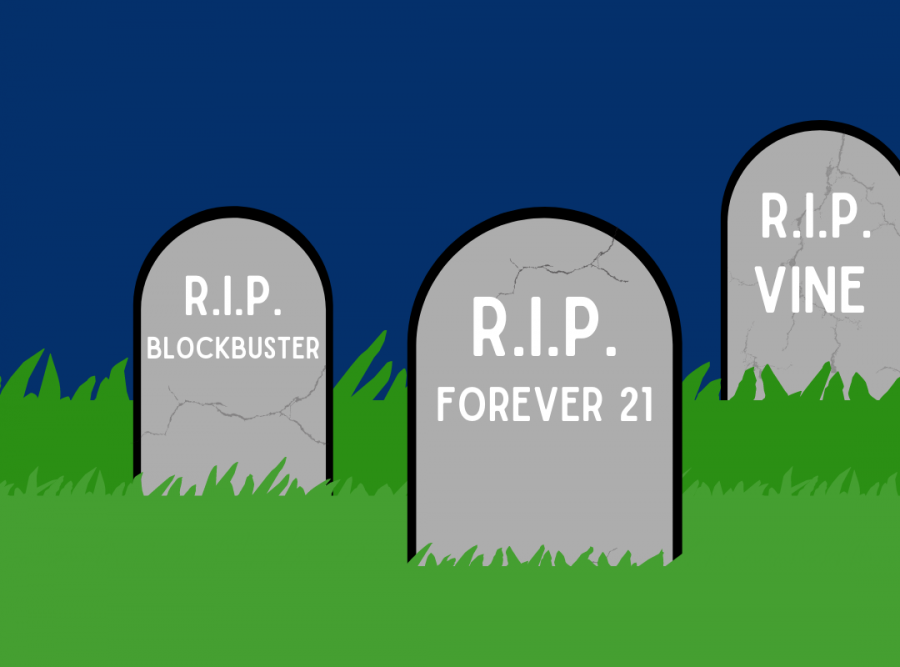Blockbuster, Forever 21, and Vine: three very different companies.
Yet they all have one thing in common – they went out of business.
These companies expanded quickly across the United States and became popular globally with both teens and adults. The brands were making millions of dollars each year. So what happened?
A combination of factors ultimately led to the demise of these businesses, as they struggled to adapt to consumer wants and needs.
“Companies need to be able to adapt to changes in society around them and listen to what customers want and don’t want; otherwise, it’s really hard for them to survive,” said Anjali Jindal, the co-founder of the business Cartken.
Blockbuster’s story
Blockbuster was the place to rent physical movies before Netflix.
At its peak in the late 1990s, Blockbuster had over 65 million customers and owned more than 9,000 video-rental stores in the United States, according to Business Insider. In fact, Blockbuster earned over $800 million just in late fees. One decade later, Blockbuster has only one store remaining in the U.S. What changed?
Netflix was a DVD-by-mail rental service company founded in 1997 that provided convenience and flexibility. Blockbuster couldn’t provide its customers with these services. With Netflix, customers could make a list of movies they wanted to see and, in one business day, get three DVDs, all without waiting in line. They could keep them as long as they wanted, without late fees, and then return them for free. If they returned one, Netflix would send them another movie from their list for $20 a month, as reported by Business Insider.
“Netflix had a flexibility that wasn’t present with Blockbuster. You have the convenience of selecting movies from your own home, movies were never out of stock, and you could keep them as long as you wanted,” Jindal said.
Blockbuster was overconfident in their first-mover advantage, meaning they were first to enter their market. It took the store almost five years to introduce its own DVD-by-mail service and even longer to get rid of late fees. Even when they finally tried to compete, they did so with outdated technology.
In the meantime, Netflix had a completely different vision for the future of video rentals and kept innovating, eventually streaming movies online. This model helped the company expand into 190 countries and amass over 130 million subscribers, according to Harvard Business Review. Blockbuster made the mistake of not adapting to their customers’ quickly changing expectations.
Forever 21’s story
Forever 21 first opened its doors in 1984, hoping to appeal to young customers by providing the latest trends at the lowest cost. Their store model worked and the brand became popular across the United States.
Their global sales peaked in 2015 at $4.4 billion, with 480 stores, according to Business Insider. But four years later, in September of 2019, Forever 21 filed for bankruptcy.
The franchise expanded way too fast. Even as other once-popular retailers like Payless, Sears, JCPenney, and Macy’s began filing for bankruptcy in 2016 and 2017, Forever 21 continued to open new stores. And the new stores were large, with an average size of 38,000 square feet, with a maximum of 127,000 square feet, as reported by CNBC.
However, with competition from brands like Zara and H&M, sales fell, and the company struggled to pay rent, especially in more expensive, high-profile cities.
The company also missed out on the transition towards e-commerce. Their younger customer base was drawn towards online shopping. In the last several years, consumers have become more comfortable buying clothes online; especially during the pandemic, it was much safer and more convenient for shoppers to be able to purchase clothing from the comfort of their own homes.
Forever 21 missed the opportunity to provide this service for its customers.
People’s habits are changing, and what they want is changing, so companies need to be able to adapt.
— John Rowe
“Forever 21 failed for a variety of different reasons. It’s all about listening to your customer and figuring out what they want. People’s habits are changing, and what they want is changing, so companies need to be able to adapt,” said John Rowe, the Business teacher at Carlmont.
Additionally, Forever 21 failed to see the shifting trend away from fast fashion.
According to the United Nations Economic Commission for Europe, the fashion industry, with its quick production times and use of synthetic fabrics, produces 10% of global carbon emissions and 20% of the world’s wastewater.
Customers that previously didn’t mind fast fashion’s “disposable” clothing are now willing to pay more for clothes that last longer and are more sustainably made.
“I try not to support [fast fashion] because it’s bad for the environment, and I don’t believe in what they’re doing. If Forever 21 moved away from fast fashion, they could have possibly survived longer,” said Bridget Matthews, a senior at Carlmont High School.
According to Vogue, fashion companies like Zara were able to adjust to this trend by offering sustainable fibers in clothing and adopting green-only packaging, but Forever 21 was put at a large disadvantage for not adjusting to a new, sustainable attitude quickly.
Vine’s story
You may remember Vine, the video hosting social media app where users could create and share 6-second videos, which was popular before Tiktok.
Vine was a “microvlogging” platform because it facilitated shorter videos than found on YouTube—similar to how Twitter is a “microblogging” platform because it involves a short amount of text compared to traditional blogs.
Vine had hundreds of millions of users at its peak, according to VentureBeat. So why is the company no longer in business, even though they entered the market earlier than Tiktok, an app with similar features?
Vine made a few fatal mistakes.
One of the most significant mistakes is that they failed to understand their customers. Vine initially envisioned its platform as a way for users to share their 6-second vlogs with friends. But it became more of an entertainment platform, with most of its users acting as passive viewers of content from a small group of influencers. Vine was dependent on these content creators and needed to keep them happy.
But, when content creators wanted more flexibility with the video length, Vine held off and stuck with the strict 6-second limit for too long. This opened the door for competitors like TikTok to enter the market. Content creators could now make videos of different lengths and providing features like live streaming to their audiences.
“I feel like users want more content to consume, especially content longer than six seconds. Scrolling through videos that are only six seconds long makes it more difficult to find longer content that keeps you entertained. I also think that platforms like YouTube reposted Vine compilations, and people could watch videos there,” Matthews said.
They also didn’t allow the content creators, who often spent days creating content, to monetize their work. Other apps like YouTube and Instagram allowed content creators to profit off their work. Many became wealthy and famous as a result, attracting more content creators and viewers to these platforms.
“Having the ability to recognize when market trends have changed and using that information makes companies a lot more successful,” Jindal said.
























